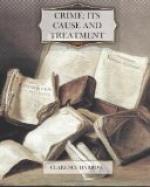As all things end, prison sentences are generally finished. The prisoner is given a new suit of clothes that betrays its origin and will be useless after the first rain, ten dollars in cash, and he goes out. His heredity and his hard environment have put him in. Now the state is done with him; he is free. But there is only one place to go. Like any other released animal, he takes the same heredity back to the old environment. What else can he do? His old companions are the only ones who will give him social intercourse, which he needs first of all, and the only ones who understand him. They are the only ones who will be glad to see him and help him get a job. There is only one profession for which he is better fitted after he comes out than he was before he went in, and that is a life of crime. Of course, he is a marked man and a watched man with the police. When a crime is committed and the offender is not found, the ex-convict is rounded up with others of his class to see, perchance, if he is not the offender that is wanted. He is taken to the lock-up and shown with others to the witnesses for identification. Before this, the witness may have been shown his photograph in convict clothes. Perhaps they identify him, perhaps they do not; if identified, he may be the man or he may not be. Anyhow, he has been in prison and this is against him. Whenever he comes out and wherever he goes, his record follows him as closely as his shadow. Even his friends suspect him. They suspect him even when they help him.
Such is the daily life of these unfortunates. What can be done? I can see nothing that the officers of the law can do. Officers represent the people. They reflect mob psychology. Even though an officer here and there rises above the crowd, as he sometimes does, it is of no avail. His place soon is filled by someone else. If only the public would understand! If only the public were more intelligent, which in this case at least would mean more human! If only the statement I repeat so often could be understood! There are no accidents; everything is the result of law. All phenomena are a succession of causes and effects. The criminal is the result of all that went before him and all that surrounds him. Like every other mortal, he is a subject for pity and not for hatred. If society is not safe while he is at large, he must be confined and kept under guard and observation. He must be kept until he is safe and a favorable environment found for him. If he will never be safe for society, he should never be released. He must not be humiliated, made to suffer unduly, despised or harried. He must be helped if he can be helped. This should be the second, if not the first object of his confinement.
Assuming that the scientific attitude toward crime should be accepted by those who make public opinion, and that this should become crystallized into written law, the problem would be easy.




